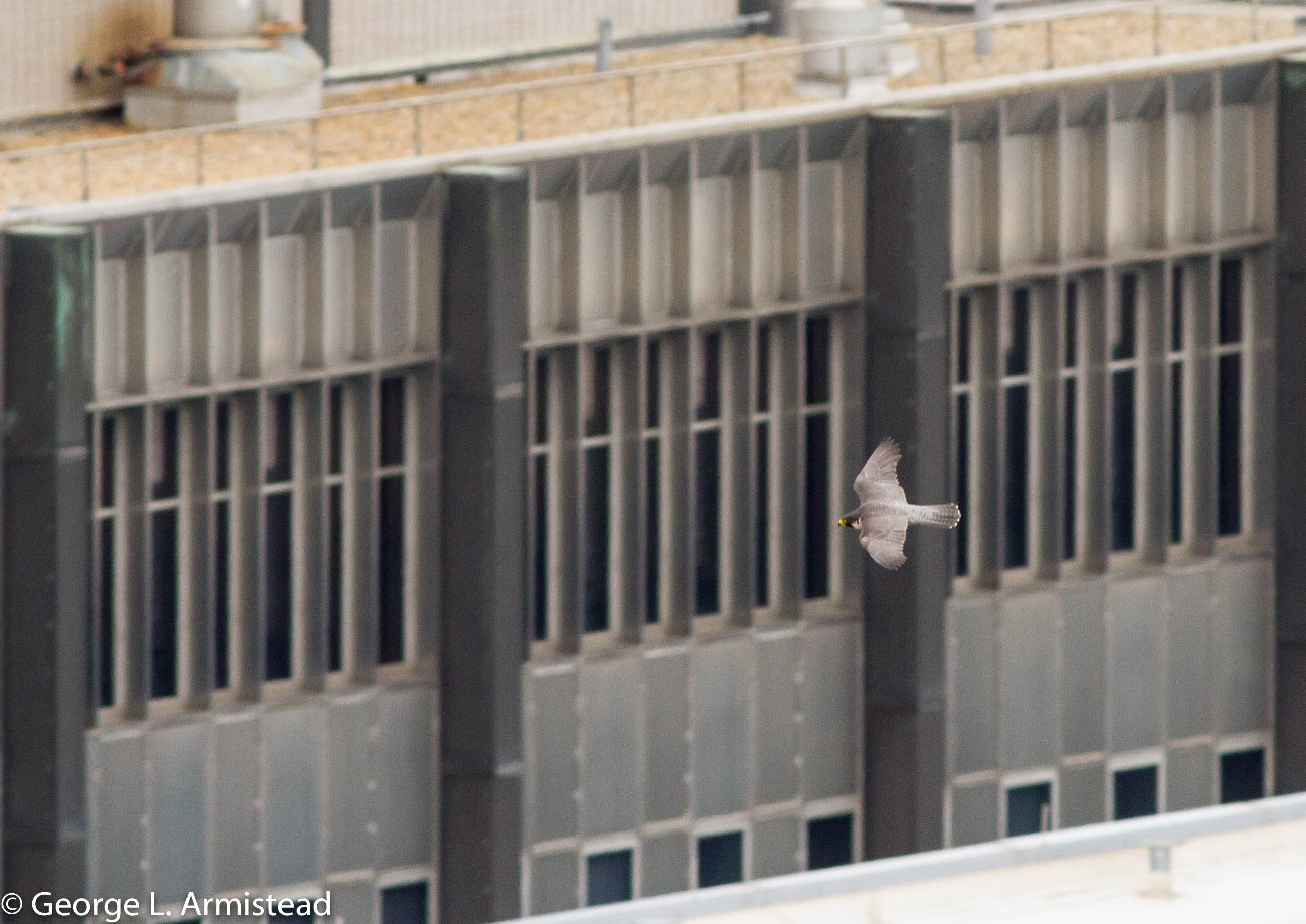Lights Out: Protecting migratory birds from illuminated skyscrapers

|
| This peregrine falcon is captured in flight in front of Philadelphia's City Hall. |
Contents |
[edit] Introduction
Architects often use glass to connect the inside and outside, but unfortunately it can literally kill the nature it attempts to put on display. In the UK, the British Trust for Ornithology estimates up to 30 million birds die every year from window strikes. In the US, up to a billion birds die each year when they collide with buildings, because they fly towards their bright, artificial lights turned on at night.
[edit] Night time illumination, skyscrapers and window strikes
Built up environments increasingly occupy or interrupt migratory routes, and artificial lighting inside these buildings can attract or confuse birds that migrate at night. Bird strikes typically increase during migratory seasons, as non-native species travel through towns and cities in unfamiliar landscapes.
These birds use natural cues - such as the earth’s magnetic field and the position of the stars - which is why artificial lighting on large panes of glass can be problematic for them. During cloudy weather, when natural cues may be obscured, birds may be even more attracted to artificial lighting.
Window strikes from birds can occur in skyscrapers when the large panes of glass act like mirrors. While strikes can happen at all levels of the building facade, they tend to happen most often in the levels comparable to those of the tree canopy.
For birds - whose eyes are positioned in such a way that makes it difficult for them to process visual information that is directly in front of them - this can create a misleading optical illusion of a clear passageway. Indoor plants and outdoor trees close to buildings can add to the confusion. Birds can die due to exhaustion brought about by disorientation.
[edit] Lights Out
In 1993, Toronto introduced the FLAP Canada programme which was the first initiative to address the problem created by lights in urban areas that were in the migratory paths of birds.
In 1999, Audubon introduced a Lights Out programme following monitoring of migratory bird strike data during the spring and fall. Those were times of year when artificial lights on at night (ALAN) and reflective and transparent glass had the most damaging effect on birds that migrate at night.
Lights Out was first introduced in Chicago and has since been adopted by cities throughout the US. In 2021, Philadelphia joined New York, Boston, Atlanta, Dallas, Cincinnati, Detroit, San Francisco and many other cities across the country.
The national initiative is a voluntary programme that involves turning off or blocking as many external and internal building lights as possible at night during migration seasons when birds are passing through the city by the millions. As part of the programme, property managers and their tenants are asked to turn off unnecessary lights between midnight and 6 a.m., especially in a building’s upper levels, lobbies and atriums, and to turn off or dim external lighting.
[edit] Related articles on Designing Buildings Wiki
- Birds and building collisions.
- Bird deterrent programmes.
- Light Pollution - Threat to Migrating Birds.
- Parleys Canyon Wildlife Bridge.
- Protected species.
- Spontaneous City at Cow Tower.
- Window.
- Window screens.
- Wired glass.
[edit] External resources
- Audubon, Lights Out.
- Flap Canada.
Featured articles and news
Lighting Industry endorses Blueprint for Electrification
The Lighting Industry Association fully supports the ECA Blueprint as a timely, urgent call to action.
BSRIA Sentinel Clerk of Works Training Case Study
Strengthening expertise to enhance service delivery with integrated cutting-edge industry knowledge.
Impact report from the Supply Chain Sustainability School
Free sustainability skills, training and support delivered to thousands of UK companies to help cut carbon.
The Building Safety Forum at the Installershow 2025
With speakers confirmed for 24 June as part of Building Safety Week.
The UK’s largest air pollution campaign.
Future Homes Standard, now includes solar, but what else?
Will the new standard, due to in the Autumn, go far enough in terms of performance ?
BSRIA Briefing: Cleaner Air, Better tomorrow
A look back at issues relating to inside and outside air quality, discussed during the BSRIA briefing in 2023.
Restoring Abbotsford's hothouse
Bringing the writer Walter Scott's garden to life.
Reflections on the spending review with CIAT.
Retired firefighter cycles world to raise Grenfell funds
Leaving on 14 June 2025 Stephen will raise money for youth and schools through the Grenfell Foundation.
Key points for construction at a glance with industry reactions.
Functionality, visibility and sustainability
The simpler approach to specification.
Architects, architecture, buildings, and inspiration in film
The close ties between makers and the movies, with our long list of suggested viewing.
SELECT three-point plan for action issued to MSPs
Call for Scottish regulation, green skills and recognition of electrotechnical industry as part of a manifesto for Scottish Parliamentary elections.
UCEM becomes the University of the Built Environment
Major milestone in its 106-year history, follows recent merger with London School of Architecture (LSE).
Professional practical experience for Architects in training
The long process to transform the nature of education and professional practical experience in the Architecture profession following recent reports.
A people-first approach to retrofit
Moving away from the destructive paradigm of fabric-first.
New guide for clients launched at Houses of Parliament
'There has never been a more important time for clients to step up and ...ask the right questions'
The impact of recycled slate tiles
Innovation across the decades.
EPC changes for existing buildings
Changes and their context as the new RdSAP methodology comes into use from 15 June.


























